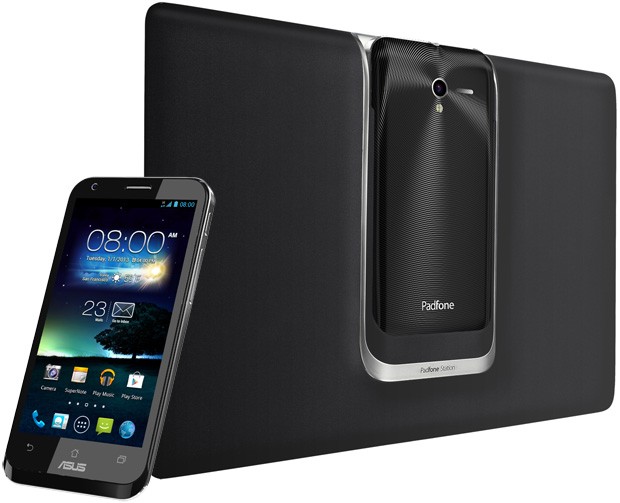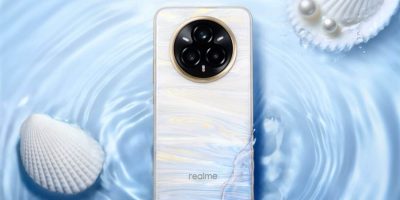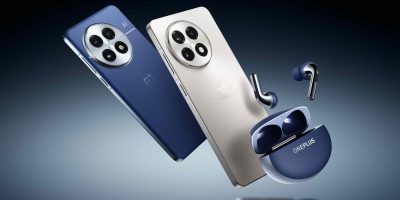
In a dual launch event spanning two continents, ASUS unveiled the followup to the PadFone, the phone/tablet combo that launched only a few months back. The new ASUS PadFone 2 improves on the original, growing the screen size to 4.7 inches while reducing the phone’s overall thickness to 9mm. The Super IPS+ display carries a 720p HD resolution and 550 nits of brightness, while a 1.5GHz quad-core Snapdragon S4 processor works in tandem with 2GB of RAM to provide plenty of power. A 13MP camera, LTE capability, and a 2140mAh battery round out the handset portion of the device.
As for the tablet, the screen size remains the same at 10.1 inches but the dock slims up and drops a few grams thanks to a smaller 5000mAh battery. The phone portion now docks via a 13-pin connector and without the trapdoor of the original. Combined, the two can reach up to 36 hours of talk time.
The PadFone 2 will hit Europe and Asia before the end of the year. Availability in other countries has not been discussed.
Live Life Intuitively with ASUS PadFone™ 2
Quad-core smartphone with incredible battery life and a thinner, lighter PadFone 2 Station deliver the ultimate mobile flexibility.
Milan, Italy (October 16, 2012) – ASUS, a global leader in the new digital era, today announces the PadFone™ 2. Building upon the successful PadFone combination of an Android smartphone and dockable tablet for incredible mobile flexibility, PadFone 2 consists of a higher-specification quad-core smartphone and a completely redesigned tablet.
ASUS Chairman Jonney Shih unveiled PadFone 2 in front of the world’s media at a press conference in Milan, Italy. “Our relentless drive to innovate through Design Thinking has empowered us to create PadFone 2. It’s beautiful, it’s fast, it’s seamless and, best of all, it’s intuitive,” said Mr. Shih.
PadFone 2 is a fully featured 4.7″ Android™ smartphone with industry-leading specifications that docks with the unique PadFone 2 Station to become a lightweight, but fully featured, 10.1″ tablet. Apps are seamlessly optimized on-the-fly to support both tablet and phone modes, with an instant transition between smartphone and tablet screen sizes.
Enlarge and Charge
ASUS’ world-renowned Design Thinking philosophy has significantly reduced PadFone 2 Station’s thickness and weight. At just 649g, the combined weight of both PadFone 2 and PadFone 2 Station is now lighter than most tablets on the market, and the dock mechanism has been redesigned to require just one swift step to use. PadFone 2 has also been subtly refined to increase its screen size to 4.7″, while reducing its thickness and weight to just 9mm at its thickest point and 135g, respectively.
Battery life is astounding, too. The higher-capacity PadFone 2 2140mAh battery provides up to 16 hours 3G talk-time and 13 hours Wi-Fi web browsing, while PadFone 2 Station’s 5000mAh battery gives up to 36 hours 3G talk-time. PadFone 2 Station’s internal battery also has enough capacity to recharge the docked PadFone 2 three times over.Super Phone, Super Performance
A 1.5GHz Qualcomm Snapdragon S4 quad-core processor with 2GB of RAM ensures incredible PadFone 2 performance in both smartphone and tablet modes. The new 4.7″ 1280 x 720 HD Super IPS+ display uses scratch-resistant Corning® Fit Glass and delivers sharp, detailed images with accurate colors, ultra-wide viewing angles and 550 nits brightness for stunning outdoor visibility.
A new 13-megapixel high-performance camera captures incredibly detailed images with no shutter lag. Burst mode can capture up to 100 shots at a blisteringly quick six shots per second, while simultaneously recording 1080p HD video at 30fps, or 720p HD video at 60fps. Low-light performance is also enhanced by the wide f/2.4 aperture and a dedicated image signal processor. Both PadFone 2 and PadFone 2 Station feature superlative sound quality too, thanks to ASUS SonicMaster technology and audio tuning by Waves, recipient of a Technical GRAMMY Award®.Easy to Share, Easy to Save
With capacities up to 64GB and 50GB of ASUS WebStorage provided free for two years, PadFone 2 offers endless possibilities for storing data. Data syncing between devices is also a thing of the past, since PadFone 2 storage is used by PadFone 2 Station when the two are connected. Shared mobile data connectivity between smartphone and tablet also means just one data plan is needed for both devices, while support for up to 42Mbit/s DC-HSPA+ and 100Mbit/s LTE delivers super-fast web browsing and downloads.
User-friendly enhancements
PadFone 2 also features a new version of the SuperNote app that instantly converts handwritten notes made in multiple languages into editable text. Its Instant Translation tool also translates any word, phrase or sentence in an email, web page or app at a touch, without the need for a third-party translation tool.
Availability
PadFone 2 will be launched before the end of December in Europe (Bulgaria, Denmark, Finland, Germany, Hungary, Italy, Poland, Portugal, Romania, Spain, Sweden) and Asia (Hong Kong, India, Japan, Malaysia, Singapore, Taiwan, Thailand, U.A.E). Availability in other countries will be announced at a later date.










I know i’m getting my hopes up but I would love to have this on Verizon.
I hear ya, I would drop the GS3 in a second. I don’t even want the dock..just give me that phone!
Agreed!
It would compliment my N7 and G-75 nicely. They make top notch hardware with amazing support.
It’s a 10.1″ phone though…
Right with ya on that one!
But I can’t help but notice…no stereo speakers?
EDIT
AND NO SD CARD SLOT????
Ponderous man, just ponderous.
NO SALE
It is a phone, it will have speakers somewhere. The SD slot is my concern, I love the onboard memory on my Galaxy Nexus but I couldn’t go without less than 32 GB.
If not the razr maxx hd will be the winner… assuming we don’t see anymore Nexus devices.
Not going to happen. They’d rather sell you two devices and then charge you two monthly fees to use them.
am I the only one abit disappointed?
No more SD slot on the phone itself, no slot on the tablet dock, non removable battery, no keyboard dock!!!…., I figured with the phone being 720p they’d make the tablet 1080p. Still no north america 3G bands
/sigh
Also I’d like to say that I hate capacitive buttons… On my GS3 I turn them off and use software buttons with home for the camera. I’d turn them off on this too but it would look habit odd because of that massive lower bezel area followed by the chin. They should’ve went with soft keys n shortened that bezel.
People will argue why do you need external storage, buy the 64gb version. Simple answer realy. l already own multiple 64 GB cards so I’d rather save 1/2/$300 and get the 16gb for apps n use my existing cards for storage.
The 64GB of internal memory just might be enough to forgive them not including SD card slot. 720p on the tab is a bit disappointing. American 3G/LTE bands will come with a later release, I bet.
+1
Main thing they needed to tackle from the padphone 1 was the price. Instead this is more expensive, loses SD slots and removable battery, etc. The near phablet size of the phone also seems like an odd choice since it docks into a bigger screen. Seems like they went the exact wrong direction with everything…
It does have a better CPU and is lighter, but even so, I think I would rather have a padphone 1, even if this was the same price. Had high hopes for this, but I am pretty disappointed.
64 internal plus 64 SD would be awesome.
I never noticed it has no SD card slot.
Sigh.
Never mind. No sale.
How did you implement the software buttons on the GS3? I’ve been wanting to add a forward and dedicated search button.
http://forum.xda-developers.com/showthread.php?p=32328345
Flash one if these zips to enable soft keys. I prefer the one which turns the hardware home key to a dedicated camera button. In CM10 in settings>system you can then edit which softkeys are shown/hidden.
If that’s a textured back, then it looks really nice.
Sick specs!
Original adopters… Sell now.
Original Padfone owners have been screwed the moment rumors about this one started.
Don’t worry, people who buy this will be screwed the moment they release a windows 8 version.
Doubt it. Seeing how Microsoft just priced themselves out of competition with the WindowsRT tablets, I bet Asus’ target demographic for Padfone will nver give Win8 Surfaces a second look.
If they also release a lapdock accessory that spins up Ubuntu when connected to the keyboard, I’d be all over this like flies on sh*t.
nom nom nom… sh¡t
I’d be on this like a fat kid on a cupcake, but why, OH WHY, are manufacturers insistent on building devices with capacitive buttons? I can’t understand this fail in reasoning. ICS/JB is perfectly fine, even better, with the on-screen buttons. Apparently someone at ASUS forgot that it’ll be awkward going from capacitive buttons on the phone to on-screen buttons when docked. As an owner of the Transformer Infinity Pad, I was looking to replace my Galaxy Nexus with this beast (I wouldn’t get the tablet dock) because I really like ASUS’s build quality. Massive FAIL ASUS.
Software buttons aren’t as great as they’re made out to be, without an adaptive command bar all the software buttons do is conusme space on the homescreen instead of on the bezel, and if you have to have a bezel you may as well make it a functional part of the phone by essentially “adding” screen space. If they move to 5inch screen on a 136×70 dimensions the sure, add software buttons, but if they consume .3 of my screen realesate and I have a bezel anyway (LG Nexus G for example) then why bother?
Have you used a Galaxy Nexus? And the reason why software buttons are as great as they’re made out to be? http://phandroid.com/2012/08/04/menu-button-issue-to-be-fixed-for-all-htc-one-x-and-htc-one-s-devices/ Enough said.
What’s your point? HTC devices already got a fix, by making the switch-window button to also a menu button (it serves 2 purposes)… Before the update, there would be a menu button taking some screen estate, just like the Galaxy Nexus on some apps… If anything, now capacitive buttons are better because there’s no annoying menu button taking up screen estate…
Has it occurred to you that maybe Google wanted capcitive buttons over software buttons with these new Nexus devices? Could be a possibility… Can’t say for sure though until I see all the rumored Nexus devices
What’s wrong with capacitive buttons? I personally prefer them over software, because they are physical rather than software-related.. Things can bug out, including the software buttons, so to have physical capacitive buttons, it’s not a bad thing
If you’re going to have an LCD, without the perfect blacks of AMOLED, then capacitive buttons aren’t so bad to me. Besides, it makes more use of the bezel at the bottom of the phone as the capacitive buttons take almost no space internally, then there is more screen real estate. As long as they use the standard 3 buttons that started in ICS (and not that crap on the GS3) I’m fine with it.
now that is a nice phone
Will this device come with the same attention to quality as the N7, Prime and Infinity? Thanks, but I’ll pass.
Non-removable battery? Not a problem with that tablet w/5000 mAh battery.. No sd card slot? Not sure of how much storage it has internally, but that Asus WebStorage is pretty nifty.. I got a Asus laptop that I use WebStorage to store some docs/videos.. I would be able to watch it on this if I get this device
I personally think this phone is a win…
I can deal with the memory and the battery, but the lack a keyboard dock is a no-go for me. And I SWEAR by ASUS, so this is a big deal for me that they made something I don’t want.
Bluetooth keyboard.
Works like a charm. You should try it sometime.
I love my bluetooth keyboard..
You should try a Transformer to know why a bluetooth keyboard doesn’t even touch it. It turns into a really solid little laptop/netbook… very easy to use in your lap kicking back on the couch to write some emails… add it that it charges up the tablet for later use and its an amazing combination.
a separate bluetooth keyboard just wouldn’t cut it.
Samsung…10.1″ Phablet-phoneblet-tabphoning-telephonetabs-whatchamacallit with super high resolution, big, big battery and other goodies. Make it compatible with the Galaxy S3 like this product and there ya go! :)
No one wants an Asus phone. But we want Asus tablets. Problem? Yes!
I hope the quality is as good as the look!
That hspa+ tag gets my att stiffy goin…… I hope we end up seeing it on this side of the pond tied to att!
*performs belt tuck
Yes, please!
I was really into the idea of the Padfone when the first one was announced and was ready with cash to get one. I waited and waited and waited and nothing. The original one still cant be bought in high street stores in the UK. I now have x2 nexus devices so I’ll be skipping the padfone 2.
Looks like a good design and build quality… This seems to be the Q4 2012 specs now. The S4 Pro, 2 GB ram, 1280×720 4.7″ screen (still don’t know why this needs to be so big 4.3″ was perfect). and 13MP camera (if it’s better than the 8MP cams remains to be seen), ~9mm thickness, ~135g weight, LTE of course. Could be a little thinner and lighter still, and a little smaller in my opinion. The width is annoying 1 handed, not the height so much.
Bottom line is now that all Android phones have this crap it comes down to which one will receive updates and evolve for the 2 years of ownership. That’s the Nexus, period.
Here’s what I like about this: ASUS gets it right by not overbearing this phone with a skin or crappware. They provide some useful, attractive widgets, and present us with a stellar design. I’d love to get my hands on a VZW version of this (not going to happen, I know) and see how it holds up against what I’ve used before.